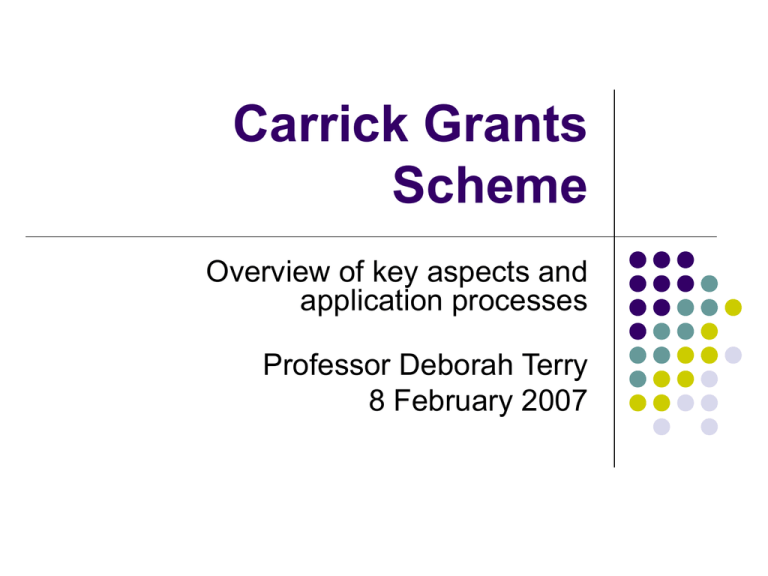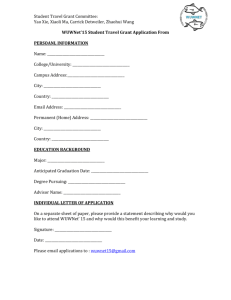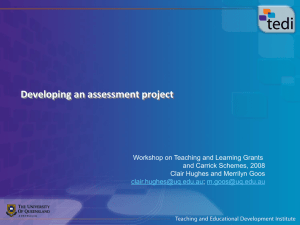Carrick Grants Scheme Overview of key aspects and application processes
advertisement

Carrick Grants Scheme Overview of key aspects and application processes Professor Deborah Terry 8 February 2007 Carrick Grants Scheme Principles Principles Compliance with the Carrick Institute mission, objectives and values Transparency Value for Money High Impact Future Looking Carrick Grants Scheme Objectives Carrick Institute Objectives Promote systemic change Recognise fundamental importance of higher education learning & teaching Develop mechanisms to identify, develop and disseminate good practice Establish reciprocal national & international sharing & benchmarking Identify important future-oriented issues that impact on higher education and facilitate national approaches to them Carrick Grants Success Rates Competitive Grants program Leadership for Excellence in Learning and Teaching program 19% national success rate in 2007 (154 applications, 29 approved) 12% national success rate in 2007 (25 applications, 3 approved) Priority Projects program 33% national success rate in 2007 (33 applications, 11 approved) UQ’s 2007 success rate over the three programs was 25% (16 applications, 4 approved) Competitive Grants Funding priorities 2008: Research and development focussing on issues of emerging and continuing importance Strategic approaches to learning and teaching that address the increasing diversity of the student body Applications for 2008 must address the issue of student diversity directly applicants should not assume that projects addressing students are by implication addressing the “diversity of the student body”. Innovation in learning and teaching, including in relation to the role of new technologies Funding of up to $220,000 available for projects of up to 2 years Leadership for Excellence in Learning and Teaching Funding priorities 2008: Institutional leadership to enhance learning and teaching through leadership capacity-building at the institutional level Disciplinary and cross-disciplinary leadership to enhance learning and teaching through leadership capacity-building in discipline structures, communities of practice and cross-disciplinary networks Funding range: $150,000 to $220,000, Projects duration: up to 2.5 years Funding range: $80, 000 to $220,000, Project duration: up to 2 years Consolidating leadership by building on the outcomes of previously funded Leadership grants Funding range: $80, 000 to $120,000, Project duration: up to 1.5 years Priority Projects Funding priorities 2008: Academic standards, assessment practices and reporting Curriculum renewal development of contemporary curricula that meet student & employer needs and provide the basis for ongoing personal and professional development for students Teaching and learning spaces Academic Standards: basis of grading decisions and decisions about student performance; development and description of a shared understanding of ‘standards’ Assessment and Reporting Practices: developmental, diagnostic and summative assessment and feedback to students etc design & evaluation of leading edge learning spaces pilots or prototypes that will transform both spaces and practice - these can include an asset budget (not capital works) where the asset is integral to the change in practice projects that build on the outcomes & findings of 2007 “Spaces and Places – for learning” Peer review Development of systems of peer review of learning and teaching across Australian higher education institutions. Funding of up to $220,000 available for projects of up to 2 years Application Preparation Acknowledgements to Denise Chalmers, Carrick Institute Review guidelines for all grants programs before deciding which to target Each program has its own funding priorities – match your idea with the right program! Review other Carrick resources including: Carrick Institute mission, objectives and values, checklists, assessment reports (2006-7), project management information, previous and current projects/grants reports and activities Review your own ideas/proposal – is it sufficiently different, or add a significant development and/or extension to what currently exists? Do your homework - review the literature and develop a sound theoretical basis for the project. Application Preparation Acknowledgements to Denise Chalmers, Carrick Institute Establish your team/collaborators – one of the key Carrick Values is collaboration Be strategic, will this team impress? Is the team coherent? Does it include a range of skills, contributions – are these clear? Is it a collaborative team? Do you have a track record of working together? Is there an established relationship? Are the members all committed? Involve all members in planning & writing the application Address all the criteria and follow the guidelines Demonstrate how it fits the scheme throughout the submission Provide a pithy, compelling synopsis of the project on first page. Include discipline/focus and intended outcomes – avoid jargon Ensure coherence between each/all section - objectives, outcomes, dissemination, evaluation, budget etc. Have it reviewed by colleagues, successful grant holders, assessors Feedback and Advice from Previous Rounds Project goals and outcomes cannot be just about UQ Carrick is focussed on enhancing T&L in higher education nationally – collaboration, dissemination and scope of projects are key Organise your collaborating parties in advance to avoid problems in the future National and/or international implications Cross-disciplinary application Industry engagement You will need to get support from each collaborating institution’s DVC/PVC Be clear about expectations of collaborators Come to agreement on funding arrangements between institutions If you are a collaborator on a grant led by another institution they may wish to enter a sub-agreement with UQ which will need to be signed centrally Projects should promote change in the sector Long-term and sustainable High Impact Practical outcomes – how will they be embedded in practice? Feedback and Advice from Previous Rounds Dissemination and evaluation strategies are often addressed poorly Engaged dissemination as well as information provision - embedding project outcomes Evaluation of the project process and well as the project outcomes Discussed in more depth in a later presentation Need to demonstrate that you are aware of work being done in the project area Carrick don’t want to fund people repeating the same work Check currently funded projects Knowledge of up to date research and studies Carrick may request that you vary your proposal – e.g., collaborate with other applicants Feedback and Advice from Previous Rounds Familiarise yourself with the Carrick Funding Agreement – there is little room for negotiation Intellectual Property issues need to be considered and addressed in the application if necessary Check budgets Make sure there are no simple mistakes and follow the Carrick template provided Budget items need to be clearly related to project activities and outcomes Submission and Endorsement Process Applicants can initially submit either an Expression of Interest or Full Proposal for each program Full proposals will be immediately considered following submission in the 1st round Successful Expressions of Interest will be requested to submit Full Proposals in the 2nd round (no new proposals in the 2nd round) Different submission dates for each program UQ Submission and Endorsement Process UQ has an internal review and endorsement process for each program 1st draft EOI’s and Proposals distributed for peer review Feedback incorporated 2nd draft considered by UQ Review Committee Feedback incorporated Final drafting and submission to Carrick UQ Submission and Endorsement Process - Dates A full flowchart of the review process is available in the T&L website and in your handouts Competitive Grants Leadership for Excellence in Learning and Teaching Priority Projects Submission to Office of the DVC (T&L) Submission to Carrick Wednesday 27 February Monday 17 March Tuesday 1 April Thursday 27 March Thursday 10 April Wednesday 23 April Questions?



